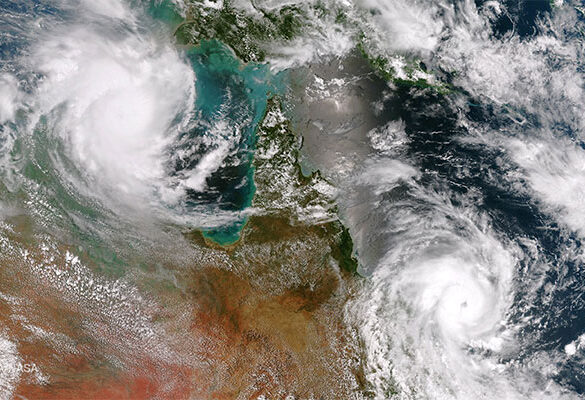Table of Contents
The key differences between cyclones and tornadoes
Cyclones and tornadoes are two powerful atmospheric phenomena that often capture our attention due to their destructive capabilities. While they both involve rotating winds and are associated with severe weather conditions, they differ in various aspects, including their formation, size, and impact. In this article, we will delve into the key differences between cyclones and tornadoes, exploring their distinct characteristics, formation mechanisms, regional occurrence, and the implications they have on human lives and infrastructure. By gaining a deeper understanding of these weather phenomena, we can enhance our preparedness and response strategies to mitigate their potentially catastrophic effects.
1. Introduction: Understanding Cyclones and Tornadoes
When it comes to extreme weather events, cyclones and tornadoes are often mentioned in the same breath. However, despite their similarities, there are some key differences between the two. So let's dive into the swirling world of cyclones and tornadoes and unravel their distinct characteristics.
2. Formation and Characteristics of Cyclones
Cyclones, also known as hurricanes or typhoons depending on their location, are powerful swirling storms that form over oceans and seas. Tropical cyclones are born in warm tropical waters, while extratropical cyclones develop in cooler regions. Despite their differences in origin, both types of cyclones share common characteristics, such as rotating winds, low-pressure centers, and the potential for heavy rainfall and strong winds. In simpler terms, they're like the rebellious siblings of Mother Nature, causing chaos wherever they go.
3. Formation and Characteristics of Tornadoes
Now let's shift our attention to tornadoes, those infamous funnel-shaped vortexes that strike fear into the hearts of those living in tornado-prone areas. Tornadoes typically form within severe thunderstorms, with two primary types: supercell and mesocyclone tornadoes. Supercell tornadoes are the big showstoppers, forming from supercell thunderstorms and often lasting longer. Mesocyclone tornadoes, on the other hand, form from smaller storm systems and tend to be less intense. But no matter their type, tornadoes share common characteristics like high winds, spinning columns, and the ability to lift houses and send cows flying (yes, really).
4. Differences in Size and Scale
While both cyclones and tornadoes are powerful weather phenomena, they differ significantly in size and scale. Cyclones are vast, expansive systems that can span hundreds of miles, wreaking havoc over entire coastlines with their strong winds and torrential rains. Tornadoes, on the other hand, are more compact and localized, typically only a few hundred yards wide. It's like comparing a giant, rampaging elephant to a nimble, destructive cheetah. Both are impressive but in very different ways.
So, the next time you find yourself caught up in a discussion about these swirling wonders, remember the key differences. Cyclones are the larger-than-life troublemakers that dominate coastlines, while tornadoes are the sneaky, smaller-scale troublemakers that pack a powerful punch. Stay safe out there, and may the winds always blow in your favor!
5. Variances in Formation Mechanisms
5.1 Atmospheric Conditions for Cyclone Formation
Cyclones, those spinning monsters of destruction, have quite an elaborate formation process. It all starts with warm ocean waters, providing the necessary fuel. As the air above the warm waters rises, it creates a low-pressure area. And just like that, Mother Nature's air conditioning system is turned on. The surrounding air rushes in to fill the void left by the rising warm air, causing a rotating motion to develop. This rotating air, combined with the Earth's rotation, gives birth to our big bad cyclone.
5.2 Atmospheric Conditions for Tornado Formation
Tornadoes, on the other hand, are like the rebellious teenagers of the weather world. They don't need warm ocean waters to form, oh no. Tornadoes prefer a different recipe - a clash of air masses. Picture a swirling dance between warm, moist air and cold, dry air. When these two air masses collide, chaos ensues. The warm air wants to rise, but the cold air pushes it back down, creating a spinning vortex. It's like a dramatic tango, but with disastrous consequences.
6. Impact and Destruction: Contrasting Effects of Cyclones and Tornadoes
6.1 Destruction Caused by Cyclones
When cyclones decide to pay us a visit, they don't hold back. With their long duration and vast size, they can wreak havoc over large areas. Coastal regions often bear the brunt of their ferocity, enduring strong winds, torrential rainfall, and storm surge. These troublemakers can also bring along their friends, such as flooding and landslides, further adding to the chaos. So, if you see a cyclone approaching, it's time to batten down the hatches and pray to the weather gods for mercy.
6.2 Destruction Caused by Tornadoes
Ah, tornadoes, the unruly cousins of cyclones. While they may be smaller in size, they certainly make up for it with their sheer intensity. With winds that can reach mind-boggling speeds, tornadoes can turn even the sturdiest buildings into matchsticks. These twisters love to play a game of hide-and-seek, popping up unexpectedly and leaving a trail of destruction in their wake. They are like the unruly toddlers of the weather world, creating chaos wherever they go.
6.3 Comparing the Impact
In the battle of destruction, both cyclones and tornadoes have their unique flair. Cyclones like to spread the love over large areas, causing widespread damage and chaos. Tornadoes, on the other hand, prefer a more targeted approach, leaving a trail of destruction in their narrow path. So, whether you prefer your destruction to be all-encompassing or localized, these weather phenomena have got you covered.
7. Regional Occurrence and Frequency
7.1 Cyclone-prone Regions
Cyclones have their favorite vacation spots, and they aren't shy about showing up uninvited. Coastal regions in tropical and subtropical areas tend to be the preferred holiday destinations for these swirling monsters. The Indian Ocean, the Caribbean Sea, and the western Pacific Ocean are just a few of the hotspots they frequent. So, if you're planning a peaceful beach getaway, it might be wise to check the cyclone forecast first.
7.2 Tornado-prone Regions
Tornadoes, being the impulsive troublemakers they are, can't resist a good chase across the Great Plains of the United States. This region, known as Tornado Alley, is like a magnet for these swirling mischief-makers. The central United States experiences more tornadoes than any other country, thanks to the perfect combination of warm, moist air from the Gulf of Mexico and cold, dry air from Canada. So, if you find yourself in Tornado Alley, brace yourself and hold on tight.
7.3 Comparing Occurrence and Frequency
When it comes to frequency, tornadoes have a bit of an advantage. They can appear more frequently within a given region, while cyclones tend to be less frequent but more widespread. So, depending on whether you prefer frequent but localized chaos or a rare but massive disruption, you can choose which weather phenomenon suits your taste. It's like having options on a weather menu but with a side of destruction.
8. Mitigation and Preparedness: Dealing with Cyclones and Tornadoes
When facing the wrath of nature, it's important to be prepared, even if you can't book a last-minute flight out of town. Both cyclones and tornadoes require their own set of preparedness measures. For cyclones, having a sturdy storm shelter and being well-stocked on essentials like food, water, and batteries can make all the difference. Tornadoes demand a similar approach, with special attention to creating a safe room and having a reliable method of receiving weather updates, such as a weather radio.
Remember, even though these weather phenomena can be awe-inspiring and terrifying, it's crucial to stay informed and take the necessary precautions. Mother Nature always has a few tricks up her sleeve, but with a little wit, preparedness, and maybe a lucky charm or two, we can face whatever she throws our way.
In conclusion, understanding the disparities between cyclones and tornadoes is vital for comprehending the diverse nature of severe weather events. While cyclones and tornadoes share some similarities, such as rotating winds, their formation processes, size, and impact on different regions vary significantly.
By recognizing these distinctions, we can better prepare ourselves, develop effective mitigation strategies, and strengthen our resilience in the face of these powerful natural forces. By staying informed and taking appropriate precautions, we can minimize the risks associated with cyclones and tornadoes, ensuring the safety and well-being of individuals and communities in their path.
FAQ
1. Are cyclones and tornadoes the same thing?
No, cyclones and tornadoes are not the same thing. While both involve rotating winds, they differ in terms of their formation mechanisms, size, and impact. Cyclones are large-scale weather systems that form over warm ocean waters, while tornadoes are smaller, localized storm systems that form within severe thunderstorms.
2. Which regions are more prone to cyclones and tornadoes?
Cyclones are more commonly associated with coastal regions, particularly in tropical areas, such as the Atlantic and Pacific Oceans. Tornadoes, on the other hand, are more prevalent in certain regions, including Tornado Alley in the central United States. However, tornadoes can occur in various parts of the world, including Europe, Asia, and Australia.
3. Can cyclones and tornadoes be predicted?
While meteorological advancements have improved our ability to predict cyclones and tornadoes, they can still be challenging to forecast with absolute accuracy. Meteorologists use various tools, such as satellite imagery, weather radar, and computer models, to monitor atmospheric conditions and provide early warnings. However, the rapid formation and localized nature of tornadoes make them particularly difficult to predict in advance.
4. What precautions should I take during cyclones and tornadoes?
During cyclones, it is crucial to follow evacuation orders and seek shelter in sturdy structures away from coastal areas. Stay updated with the latest weather information and be prepared with emergency supplies, including food, water, and first aid kits. In the case of tornadoes, identify a safe place in your home or workplace, such as a basement or an interior room on the lowest level, and take cover. Stay tuned to local weather alerts and have a tornado emergency plan in place.




